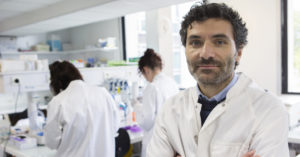Sickle-cell anemia: a project involving the Gene editing team has just secured European funding
The “EDITSCD” project, that aims to improve gene editing strategies for sickle-cell anemia, this hereditary disease of the red blood cells, has just been selected by the European Union. It will involve a dozen or so research laboratories in Europe, among then the Gene editing team (Inserm UMR 951) headed by Mario Amendola at Genethon.

“The aim of this program over 5 years is to improve gene editing strategies for sickle-cell anemia, and optimize the targeted integration of DNA,” explains Mario Amendola, head of the Gene editing team. The research project also aims to better control the collateral effects of the use of CRISPR-Cas9, the now-renowned “genetic scissors”, through development of different technologies.
The Horizon-RIA project will fund research in the amount of 800,000 euros, for this program estimated to cost a total of 6 million euros, and slated to bring together collaborators from institutions in France, Italy, Switzerland, the Netherlands, Israel, Germany and Sweden.
It signals a true hope for people suffering from this disease for which treatment to date is only symptomatic. A gene therapy trial using a product from Genethon’s R&D division, with AP-HP as sponsor, is currently ongoing.
Sickle-cell anemia is the most common genetic disease in humans. In France it affects around 1 birth in 3,000, with a higher than average occurrence in African and West Indian communities. It is due to a mutation of the coding gene for beta globulin, located on chromosome 11. This mutation causes an anomaly of the hemoglobin, which carries oxygen in the blood. The symptoms are highly variable from one person to another, and can include anemia, repeated infections and pain crises caused by poor blood flow.

